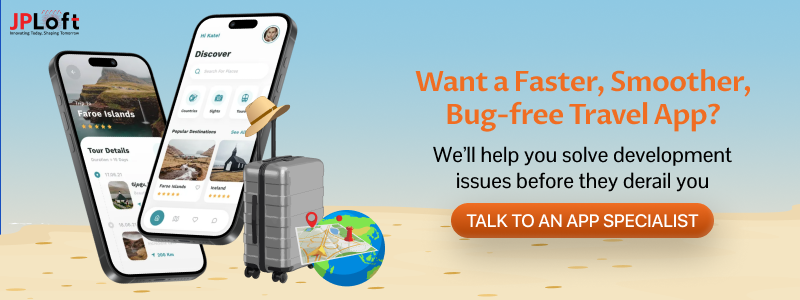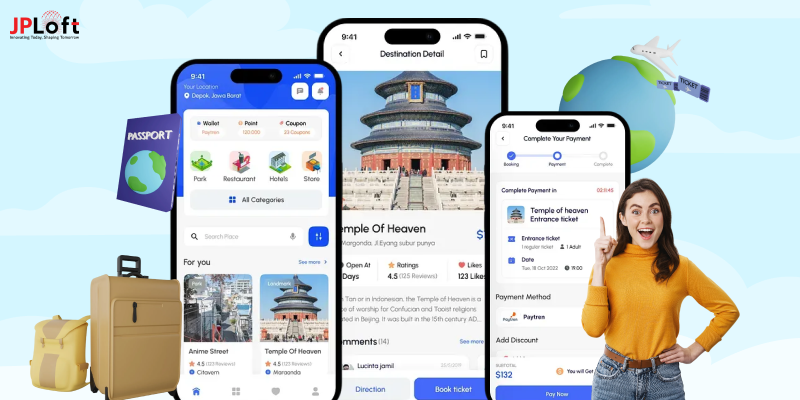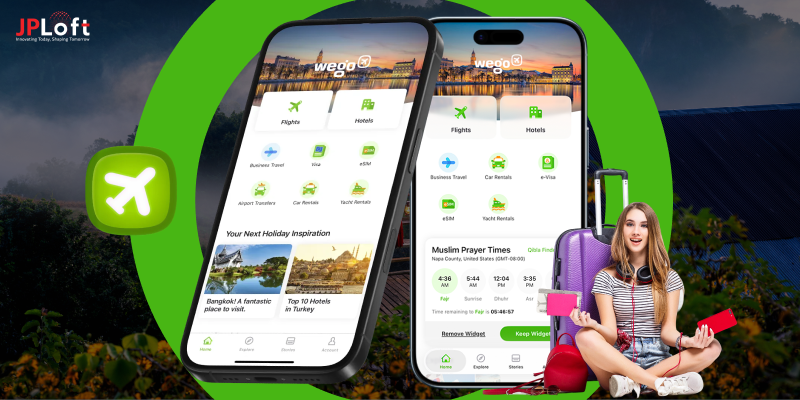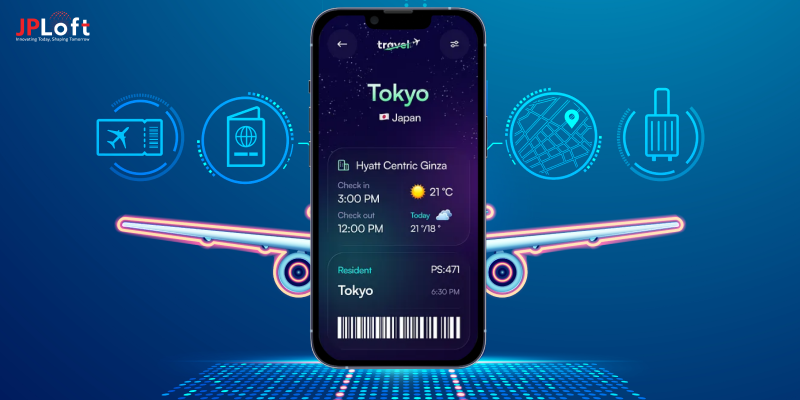The world has been changing since the COVID-19 pandemic, and one clear differentiator in the world today is the frequent use of travel apps by visitors.
From booking tickets to hotel reservations, travellers are turning to travel apps to meet all their travel needs.
Over the last decade or so, people have increasingly turned to travel apps for a range of functionalities, including trip planning, ticket purchasing, and even hotel and flight booking.
Developing a travel app can be fruitful in driving customers to your home-grown resources.
Before you decide on the kind of travel app you wish to build, let’s look at the major travel app development challenges and everything a travel app can be once those are fixed.
Travel Apps: An Overview
The travel industry has seen an overhaul globally since the pandemic.
Having spent time forced indoors, travellers are now travelling more and especially to more offbeat places.
Travel apps have emerged as a gateway to streamlining the travel experience for most users.
These apps can be used to explore places, book flights and accommodation, and even look up local recommendations.
For the convenience of those with wanderlust, travel apps go a long way by ensuring they can avail personalised recommendations anywhere they are. The most common features of a travel app include:
-
- Planning and booking
- Navigation and transportation
- Information and personalised recommendations
- Communication and translation
- Document management
The popularity of travel apps is further driven by people’s increasing desire for sustainability in every part of their travel experience.
The need for community and sharing experiences with those holding common interests is a key trend shaping the travel industry. This is showing up in increased interest in sporting events and games.
As per the American Express 2025 Global Travel Trends Report, 74% of global respondents stated that they plan on taking 1-3 domestic trips in 2025.
It seems like travel apps are here to stay. This is why businesses want to create a travel app and hop on the trend.
Travel App Market Stats
Travel app developers and builders are set to see revenues soar over the coming years, with increasing usage of apps to book entire itineraries.
-
- Globally, revenue in the travel app segment is projected to keep increasing by 36.59% or USD 0.6 billion between 2025 and 2029.
- As per the May 2025 World Tourism Barometer from UN Tourism, the first three months of 2025 saw 14 million more tourists travel internationally than in the same period of 2024.
- The online travel market was valued at USD 566.74 billion in 2024 and is projected to rise to USD 1.37 billion in 2033, demonstrating a CAGR of 9.85%.
With figures such as this, it is only a matter of time before users are exclusively turning to mobile apps to book their travels.
This may well be the best time to jump onto that bandwagon and make sure you are not left behind as the world around you evolves.
10 Travel App Development Challenges and Their Solutions
As the demand for building travel apps increases, it is vital to consider the different needs of users.
Read through these travel app development challenges as shared by users on a travel app and strive to avoid the same mistakes.
Remember that most of these challenges can be eradicated by considering mobile app security and user convenience as the leading tenets of your app development.
1. Unintuitive Interface
A lot of times, developers build an app as per their individual specifications, but it ends up being difficult for users to navigate.
For instance, a long-winded user journey from browsing destinations to booking accommodation and flight can be frustrating for users and often force them to turn to other platforms.
Solution: Before you create an app in the travel niche, conduct thorough research to identify the ideal user journey using the app.
This will help you devise the ideal user journey by collecting feedback from potential users.
Additionally, you could gather insights into how different users utilize the app, thereby ensuring a more equitable experience for all users.
2. Slow Responses
No matter how good an app is, slow loading times or frequent app crashes can result in a poor user experience. This can result in users migrating to competitor sites for a more seamless travel booking process.
Solution: Optimising your code for performance is essential for building an app that does not crash or result in slow loading times. Other mobile app ideas to improve performance include compressing images and implementing caching mechanisms.
Before launching the app, it is crucial to perform thorough testing, including stress testing, in order to identify and address potential performance bottlenecks that may result during the app’s usage.
3. Translation Issues
How do you build an app that offers native experiences for users globally?
Catering to a global audience is the need of the hour, but it can throw up unique challenges in travel app development, such as the need for translation services within your app.
Solution: Extensive localisation of the app can make it usable for travellers across the world. This could include translation features on the app or even adapting the user experience for different regions of the world using real-time translation APIs.
Another trick could be to use more icons or symbols that are globally understood, such as a plane for flight booking or a hotel icon for accommodation.
An additional feature to include would be language assistance that helps users communicate even while far from home.
4. Payment Problems
Imagine picking out a great deal for flights and accommodation, and then getting stuck on the payment page.
This can be an extremely frustrating experience, the kind that would make a user turn to a different app to meet their needs.
Some apps may even throw an error message or not support certain payment methods. All such events can result in users turning to different apps for a comprehensive travel booking experience.
Solution: While a common problem, it is not very difficult to prepare for it.
Developers can easily integrate secure mechanisms for payments that also support a range of payment methods.
It is essential to provide users with their payment method of choice in order to provide a seamless travel booking experience. Users must be able to pay with their preferred method in order to make bookings through your app.
5. Lack of Real-Time Data
A major challenge for users of a travel booking app may arise from being unable to access real-time data.
For instance, users may not be able to see the updated flight timings or prices or check hotel availability for their selected dates.
This can result in a disappointing user experience and result in driving users away.
Solution: Fetching real-time data has become easier with the availability of APIs like Google Maps, which helps with real-time traffic updates, and Skyscanner, which enables users to check for real-time flight availability.
Integrating these functionalities into your travel app can help offset challenges while creating travel apps and help users book their entire travel through your app.
6. Lack of Offline Functionalities
While travelling, especially to off-beat spots, internet connectivity can emerge as a concern for users.
Imagine travelling towards a scenic hotel and losing access to details of the accommodation you have booked.
Thus, it is always best to offer offline functionalities in your travel app. This way, your users have access to all their vital travel information even when they do not have access to the internet.
Solution: You can implement the offline mode for some key functionalities, which allows users to access these features even when they are unable to connect to the internet.
For instance, navigation to their booked accommodation and currency conversion can be offered offline, which can enhance the users’ experience.
While not all Travel app features need to be made available online, it is essential that the vital functionalities of the app be available offline.
For existing users, especially, having details of their travel booking available offline can be a major benefit while travelling to offbeat sites.
7. Frequent Crashes
As more users start accessing the app, there might be frequent crashes that ruin the user experience. This can often be caused due to higher than higher-than-anticipated traffic on the app.
During the holiday season, especially in the months leading up to the holiday season, your app may see more visitors than usual. Ensuring that the app does not crash during periods of high traffic is another common travel app development challenge.
This is among the common challenges in travel app development that sees users migrating to competitor apps, which is why it must be dealt with right at the beginning by building a scalable solution.
Solution: Cloud computing has emerged as a sustainable solution to prevent apps from crashing due to high traffic.
Using solutions like AWS, Google Cloud, or Azure can help prevent such app failures.
Load balancing or distributing network traffic across multiple servers is another technique that can help prevent frequent crashes in case of overutilization of the app.
While your app may only see high usage at certain points in time, it is best to be prepared for these eventualities right from the beginning.
8. App Draining Phone Battery
With features that include GPS, maps, and other real-time data, the usage of the app can cause the phone battery to drain very quickly.
This can be a problem, especially while travelling, since the user may not have quick access to power outlets.
Ensuring this does not happen is a major obstacle while developing travel apps.
Solution: Location tracking can be performed through battery-efficient means that help reduce the app from draining too much of the phone battery during usage.
Using progressive web apps (PWAs) can be another way to reduce the draining of the phone battery during app usage and combat one of the challenges of travel app development.
Speak to their developers and express your concerns so that a solution is implemented right at the beginning, instead of when issues arise.
9. Data Security Concerns
One of the crucial obstacles while developing travel apps relates to users and their security concerns involving the data they share.
For instance, travel apps allow users to make payments, but these payment details can then be shared by unscrupulous players in case of a data breach.
Users’ travel itineraries can also get leaked in such cases. Such concerns need to be minimised in order for a user to enjoy the travel app experience.
Solution: End-to-end encryption is one solution that you should consider implementing to eradicate these common challenges in travel app development.
Multi Factor authentication can also help in increasing the security of your travel app, although it might increase the cost to create a travel app.
The inclusion of GDPR-compliant policies can further help in enhancing security for users on your travel app. User data is sacred, and their security should be treated as of the utmost importance.
10. Lack of Personalisation
Among the major challenges in travel app development is a severe lack of personalisation for users.
Users can often feel overwhelmed by the choices they are offered in terms of flights, accommodation, or even activities that they can engage in.
Sifting through all the offerings and identifying ones to participate in can be difficult for a user without any recommendations or suggestions.
Solution: You can integrate Artificial Intelligence (AI) to provide personalised services and recommendations for users.
For instance, once the user has booked a flight to a specific destination, you can display localised activities that they can participate in around the region.
Furthermore, integrating Augmented Reality or AR in travel apps can help make the app more engaging and interesting for the user.
Such tricks enhance the user experience significantly and also allow the user to engage significantly more with the app.
How Can JPLoft Help You Overcome Challenges in Travel Apps?
JPLoft, the best travel app development company, allows you to hire dedicated developers who excel at making travel apps that are secure and personalised, and allow you to bypass the travel app development challenges mentioned earlier.
With its integration of the latest technologies and years of experience in developing responsive apps, our company is well-positioned to help you overcome challenges in travel apps and build apps as per your specific requirements.
Regardless of geography, our products are usable everywhere with heightened localisation.
We use advanced technologies such as artificial intelligence, AR, machine learning, and GPS integration to develop scalable and powerful apps that drive customer engagement and ensure the long-term growth of your business.
Conclusion
The burgeoning travel app market, while offering immense opportunities, is fraught with significant development challenges.
From ensuring an intuitive user interface and rapid response times to navigating complex payment systems, real-time data integration, and robust data security, each hurdle can impact user satisfaction.
Successfully building a resilient travel app requires proactive solutions, including thorough user research, code optimisation, extensive localisation, and leveraging cloud computing for scalability.
Addressing these critical points ensures a seamless, reliable, and secure experience, allowing users to fully embrace the convenience of modern travel.
FAQs
By implementing APIs for different services that are pertinent to travel booking, you can offer real-time services to your users. For instance, the API for a platform like Skyscanner helps users avail live information on flight times and destinations, and book accordingly.
There is no set limit to how many users can be logged onto your app at a given time. However, you should consider turning to cloud computing to ensure the scalability of your app. During festive seasons, for instance, your app could see increased traffic, and it is essential that it does not crash under the influx of visitors.
Some of the common obstacles while developing travel apps include an intuitive interface, slow loading times, and data security in terms of payments and bookings.
The offline functionality is vital among travel app features as it empowers users to conduct a range of functions even when they do not have access to the internet.
The cost can vary significantly, ranging from a few thousand dollars to more, depending on its features, functionality, and even the platform it is being built for.













Share this blog